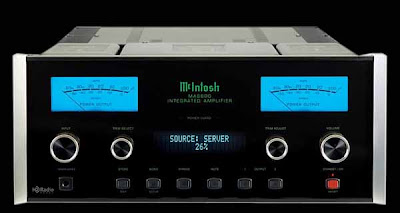
The looks of the amplifier is even more typical for McIntosh, if you can imagine that. The cabinet was split in five sections: just behind the fascia we have a compartment housing the amplifier’s control circuitry, the VU meters and their lighting and the optical fibers for lighting the logo. Behind this section there are three separate cups for the big mains transformer and two (one for each channel) adapting transformers, called autoformers by the company. The last part of the enclosure houses the audio circuitry. The glass front houses two big VU meters, scaled in output power (it is interesting to observe them – during the listening session they only rarely passed the 2W mark, while the volume was significantly high). Between the meters there is a green lit logo. Below them, there are four knobs and a alphanumeric display. This display shows blue characters on a black background and is quite readable (but would prefer a blue lit one, it would look better with the meters). The left most knob selects the active input, next one, being a bit smaller, selects menu entries, the smaller on the right selects a menu function, and the right most controls the volume. All the knobs are just impulse generators, and can be turned around without any constraints, and the functions are being displayed on the mentioned display. The lower part of the front is occupied by a headphones socket and buttons: store, mono, bypass, mute, output 1 and 2 on and off and standby. Oh, I almost forgot – above the display there are two LEDs, which light when the protection circuit is activated.
The back panel is split in two parts. The larger upper part contains the gold plated loudspeaker terminals, which accept all kinds of wire termination. Interesting are the outputs for 8, 4 and 2. This is related to the usage of autoformers. They have a similar function to output transformers in tube amplifiers – adapt the output impedance to the loudspeaker load. In the middle of this section of the back panel we find also a XLR input. The bottom part is much more crowded. To the left we have an IEC socket, then a whole array of system communication sockets and an external remote sensor connection. Then we have a battery of RCA sockets: five high level inputs, MM gramophone input, power amplifier direct input, two preamplifier outputs, one connected to the power amplifier input by a cramp, the other one is not connected, those can be switched on and off from the front buttons, and finally there is a recorder output. I have just one complaint about the RCAs – those are too close together.
Inside the amplifier we find one surprise: a socket for the optional tuner module, nicely shielded by a metal mesh. The power section is built symmetrically for both channels, on vertical PCBs mounted directly to heat sinks placed on both sides of the enclosure. Each channel consists of four pairs of transistors. Unfortunately I did not get through to the rest of the elements of the amplifier, I could only see that those were mounted on one big PCB, placed on the bottom of the unit.

MA6600 Integrated Amplifier Specifications
POWER OUTPUT
200 watts is the minimum sine wave continuous average power output per channel, both channels operating
OUTPUT LOAD IMPEDANCE: 2, 4 or 8 ohms
RATED POWER BAND: 20Hz to 20,000Hz
TOTAL HARMONIC DISTORTION
0.005% maximum with both channels operating from 250 milliwatts to rated power, 20Hz to 20,000Hz
DYNAMIC HEADROOM 2.0dB
FREQUENCY RESPONSE
+0, -0.5dB from 20Hz to 20,000Hz
+0, -3dB from 10Hz to 100,000Hz
PREAMPLIFIER OUTPUT 1 AND 2 (FOR RATED INPUT): 1.4V unbalanced (8V Maximum)
SENSITIVITY (FOR RATED OUTPUT)
High Level, 250mV unbalanced, 500mV balanced
Phono, 2.5 mV; Power Amp In, 1.4V
SIGNAL TO NOISE RATIO (A-WEIGHTED)High Level, 92dB below rated output
Phono, 84dB below 5mV input
Power Amplifier, 115 below rated output
INTERMODULATION DISTORTION
0.005% maximum, if the instantaneous peak power is 400 watts or less per channel with both channels operating for any combination of frequencies from 20Hz to 20,000Hz
WIDE BAND DAMPING FACTOR: > 40
INPUT IMPEDANCE
High Level, 20K ohms
Phono, 47K ohms; 65pF
Power Amp In, 10K ohms
MAXIMUM INPUT SIGNAL
High Level, 8V unbalanced, 16V balanced
Phono, 80mV: Power Amplifier In, 16V
PREAMPLIFIER OUTPUT IMPEDANCE: 220 ohms
VOLTAGE GAIN
High Level to Rec Output: 0dB
High Level to Output 1 and 2: 15dB
Phono to Rec Output: 40dB
Phono to Output 1 and 2: 55dB
Power Amplifier: 29dB
TONE CONTROLS
Bass Control ±12dB (1dB steps) @ 30Hz
Treble Control ±12dB (1dB steps) @ 10,000Hz

Nessun commento:
Posta un commento